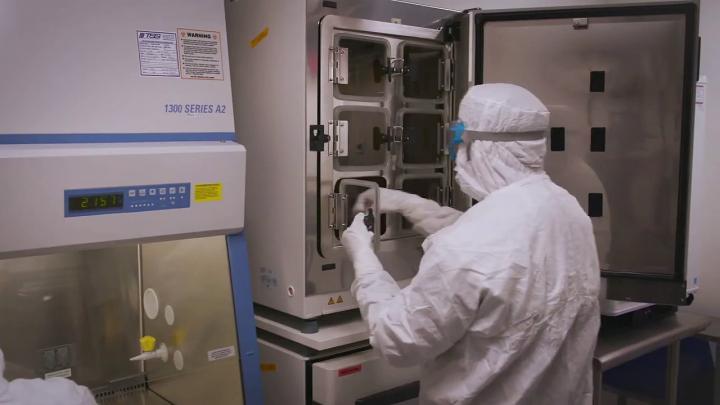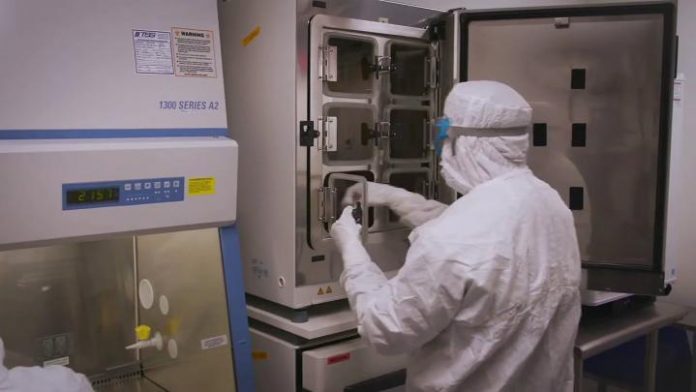
Photo: New York Stem Cell Foundation (NSYCF) Scientists at work in the NYSCF Research Institute GMP Facility
view more
Credit Image: The NYSCF Research Institute
The New York Stem Cell Foundation (NYSCF) today announced that they are developing a stem cell therapy to treat patients suffering from age-related macular degeneration (AMD). They will first target dry AMD, a disease that results from the death of a type of eye cells called retinal pigmented epithelial (RPE) cells and causes vision loss. NYSCF scientists will create healthy RPE cells from induced pluripotent stem cells –stem cells that are generated from each patient’s blood cells — to replace the damaged cells in the eye and restore vision. The RPE cells will be placed onto a specially designed patch and surgically implanted behind the retina by surgeons at Columbia University – NY Presbyterian Hospital led by Stanley Chang, MD, Stephen Tsang, MD, and Tongalp Tezel, MD, whose infrastructure and expertise will accelerate the process of bringing the technology to patients.
“I am hopeful that this therapy will lead to improving or stabilizing vision for patients with the most common form of macular degeneration,” remarked Dr. Chang. “NYSCF’s approach to creating a personalized therapy is innovative and promising, and I am happy to be a part of this exciting project.”
Last year, NYSCF completed construction of an in-house, state-of-the-art good manufacturing practice (GMP) facility to create clinical-grade cells compliant with FDA requirements. NYSCF has also developed its own process for generating clinical-grade stem cells.
“We are excited to realize the promise of stem cells in our first cell therapy and hopefully offer relief to patients who have lost their sight to AMD,” said NYSCF CEO Susan L. Solomon, JD. “This will also be critical groundwork for future cell therapies targeted at other major diseases of our time.”
CellRay LLC, a fully owned subsidiary of New York Stem Cell Foundation, Inc., recently obtained a license for the protocol to create clinical-grade RPE patches from the National Eye Institute (NEI) at the National Institutes of Health. This protocol, developed by a team led by NEI’s Kapil Bharti, PhD, is being used in a clinical trial that is currently enrolling patients with AMD. Obtaining the license as well as the execution of a collaborative research and development agreement will allow NYSCF and Cellray to leverage Dr. Bharti’s extensive preclinical work to accelerate the clinical trial timeline.
“My lab at the NEI has received FDA approval for an autologous iPSC-derived RPE cell therapy for AMD patients. The Phase I/IIa clinical trial is currently ongoing at NIH. We are excited to collaborate with scientists at NYSCF to further this technology,” Dr. Bharti explained. “Using RPE derived from patients’ own blood cells in this therapy will be uniquely advantageous because it should reduce the likelihood of immune rejection, a common issue for transplantations.”
With the new facility and licenses in place, NYSCF is now transferring the NEI’s protocols into its GMP pipeline, which will pave the way for initial interactions with the FDA about starting the clinical trial.
“We are looking forward to advancing this therapy toward the clinic,” said Howard Kim, PhD, NYSCF Senior Director of Cell Therapy Programs. “With construction of the GMP facility complete and these licenses in place, we are closer than ever to reaching patients in desperate need of new solutions.”
###
On March 23rd at 5pm, Ms. Solomon, Dr. Chang, and Dr. Bharti will have a fireside conversation discussing stem cell therapies for AMD. Register here (https:/
About The New York Stem Cell Foundation Research Institute
The New York Stem Cell Foundation (NYSCF) Research Institute is an independent non-profit organization accelerating cures and better treatments for patients through stem cell research. The NYSCF global community includes over 200 researchers at leading institutions worldwide, including the NYSCF – Druckenmiller Fellows, the NYSCF – Robertson Investigators, the NYSCF – Robertson Stem Cell Prize Recipients, and NYSCF Research Institute scientists and engineers. The NYSCF Research Institute is an acknowledged world leader in stem cell research and in the development of pioneering stem cell technologies, including the NYSCF Global Stem Cell Array®, which is used to create cell lines for laboratories around the globe. NYSCF focuses on translational research in an accelerator model designed to overcome barriers that slow discovery and replace silos with collaboration. For more information, visit http://www.
TDnews (tunisiesoir.com)















